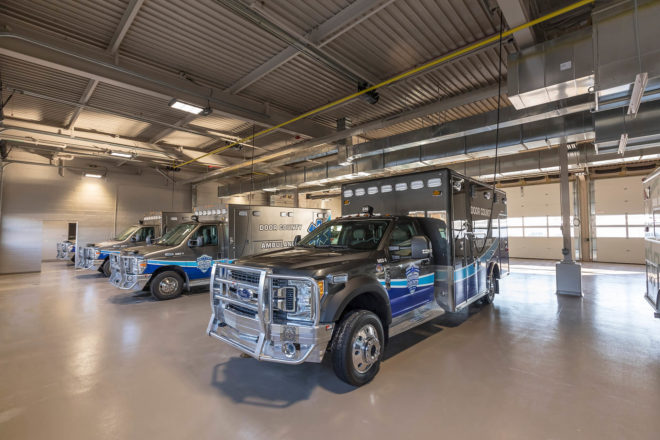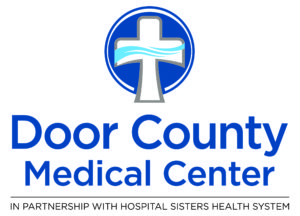County, Hospital Partnership Considered for 911 Transfers
- Share
- Tweet
- Pin
- Share

Between 1,000 and 1,200 patients are taken to the Door County Medical Center’s (DCMC) emergency room on average during July, the emergency room’s busiest month of the year. The crews do what emergency crews do: develop a finite diagnosis and, if necessary, get a patient to whichever specialty care they need, such as a cardiologist or neurologist.
Normally 10%-20% of the emergency-room patients need to be transported to these tertiary services outside the county, and for those, “it could be the difference between survival or not,” said Sandy Vandertie, DCMC’s director of operations, who spoke with the Peninsula Pulse by phone and also supplied the statistics.
This July, 107 people required a transfer to Green Bay or beyond, but they didn’t always go quickly.
“We know what our resources are; we know where they are,” Vandertie said. “But we’re challenged in northeast Wisconsin in getting them there.”
DCMC does not have its own ambulance service. Historically, it used a private local ambulance called Para Tran, a company that went out of business about four years ago. DCMC has relationships with a couple of ambulance services for transport out of the Green Bay area, but if a person is critically ill and can’t wait the length of time it takes for the ambulance to travel back and forth from Green Bay, DCMC calls Door County Emergency Medical Services (EMS), a public, taxpayer-funded county department.
If the county service can send an ambulance and crew, it’s out of the county for a good three hours. That sometimes means recalling off-duty personnel or requiring the department’s director or captain to make the trip. None of those situations are ideal, and the need is only increasing, said Aaron LeClair, Door County emergency services director.
The county ambulance service has made 79 transports this year to date, versus 64 for all of 2021.
Sometimes, his department can’t answer the call at all.
“This morning, they called after midnight to look for a crew,” LeClair said. “It was noncritical, but the patient needed to go somewhere else. We couldn’t meet that need overnight. We staff down overnight and can’t risk the crew being gone overnight. That’s why we can’t meet their need today.”
New County Transfer Division Proposed
LeClair was speaking to a joint meeting of the Door County Administrative and Finance committees Aug. 16, when members were considering personnel requests from county departments as part of the 2023 budgeting process. On that list was creating a new transfer division within the EMS department to service DCMC by transporting patients to facilities outside Door County.
“We’re not required to do the service but are in essence being called to provide the service because there are no other [ambulance] providers,” said Ken Pabich, Door County administrator.
Creating a transfer division would require eight new staff members: a new captain, billing specialist, three advanced emergency medical technicians and three emergency medical technicians. Total costs for the personnel would be $610,524. Another $265,981 would be required in startup costs, which includes purchasing another ambulance.
The grand total would be $876,505. LeClair said the request “covers everything to assure we’re not subsidizing, down to the fuel.” All of it would be offset by DCMC, Pabich said.
“We’re not going to add anything else onto the tax levy,” Pabich said. “We can’t add on a levy portion to this cost anyway, so even if the cost were higher, we would have an intergovernmental agreement with the hospital that they would make us whole to make sure we’re not expending any tax dollars related to this service.”
DCMC understands that part of the financial equation.
“Because we’re asking our taxpayer-based system to do this, that shouldn’t be the taxpayers’ role to finance,” Vandertie said. “So we understand we need to be part of the solution for that. So if we can support them with the right equipment and the right employees, that benefits everyone.”
Emergency Calls Serving Local Communities
The county and DCMC have been talking about a transfer partnership for at least a year. DCMC’s inability to secure reliable transports has been developing over time and is compounded by the health care staffing shortage, making hospital beds in shorter supply across the region.
When patients arrive in the emergency room and it’s determined they need specialty care, inquiries begin for beds in Green Bay and then extend beyond.
“When we finally get the call that we have a bed for the patient, everybody’s like, ‘Whew!,’” Vandertie said. “But now, we have to find transport.”
DCMC has used ambulance services from as far away as Wausau and Milwaukee to make this happen. But in January of this year, patient wait times for transfers were averaging just over two hours. Others have waited much longer. Families of patients, tired of waiting and against medical advice, opt to leave to drive their loved ones themselves.
“In essence, we’re failing our community when they’re put into that position,” Vandertie said.
The county/DCMC partnership would cut wait times significantly, while also preserving the county’s crew and resources for local 911 emergencies.
“The challenge here is we are not obligated to do it, but there are consequences of us not doing it,” LeClair told the joint committee.
The partnership is the right thing to do professionally and the right thing to do for the community, Vandertie told the Pulse. LeClair said essentially the same thing during the joint committee meeting.
“We exist to serve this community and this county,” LeClair said.
The hospital’s statistics show that 55% of emergency-room patients who have required a transfer have a 54235 zip code, which covers the City of Sturgeon Bay, extends as far south as Forestville and includes Sevastopol to the city’s north, as well as parts of Jacksonport and Egg Harbor.
Another 7% have Kewaunee County zip codes. The remaining zip codes are also within Door County, with the exception of 10%-12% that are “other,” Vandertie said.
Next Steps
The joint committee’s consideration of the request was a first look at the potential partnership. Committee members had questions about the details, and not everyone was on board.
“I think this belongs in the private sector,” said Supervisor Dave Englebert. “We’re doing the essential services.”
When the staff and ambulance are not transporting, Pabich said they would be available for county service and response. Englebert said he didn’t see how that could be the case if the transport ambulance and personnel had to be available for hospital transports.
“It’s not as easy of a service as it’s being made out to be,” Englebert said.
The county will take another look at the creation of the transfer division during a budget retreat scheduled for Thursday, Sept. 1, when the full County Board of Supervisors will convene with department heads. The open meeting will take place at The Landmark Resort in Egg Harbor, 8 am – 1 pm.



